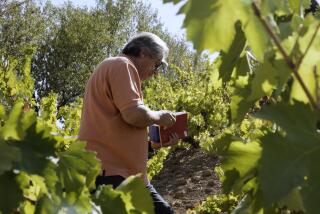‘Gruel With a Kick’: Ancient Egyptian Brewery Is Untapped
After a long day of slaving over the pottery kilns or digging tombs, the ancient Egyptians probably looked forward to knocking back a few jars of the local beverage.
Some undoubtedly quaffed the product from what archeologists believe may be the oldest brewery in the world--a recently unearthed four-vat operation capable of producing a dung-fired beer brewed from Nile water, half-baked bread, wheat malt and date juice.
“I’m describing the beer as gruel with a kick,” said Jeremy Geller, an archeologist in the anthropology department at Washington University in St. Louis. Geller is excavating the brewery in the ancient city of Hierakonpolis on the banks of the Nile about 450 miles south of Cairo. By examining pottery shards at the site and assessing a radiocarbon analysis of a mysterious black residue found in the vats, Geller estimates that the brewery was active about 5,400 years ago, before the rise of the Pharaohs and construction of the pyramids.
“If his dates hold up, it sounds like the oldest brewery in the world,” said Solomon Katz, an anthropologist at the University of Pennsylvania, who believes a robust thirst for beer was one of the main reasons prehistoric hunter-gatherers banded together to create civilizations and develop agriculture.
Geller initially was interested in studying the pottery industry that flourished along the Nile about 3,400 years before the time of Jesus Christ. On the floor of the desert, in what was once the industrial sector of Hierakonpolis, Geller noticed chunks of burned clay pots and the broken lip of a large vessel. But the pottery kiln was unlike any Geller had ever encountered.
Geller found four upright conical vats sitting on a raised platform. There was evidence that the vats were slowly heated with fires stoked with acacia and tamarisk wood and dung. Most intriguing was the presence of a glossy black residue that clung to the insides of the vats.
New Direction
“It was certainly not the kiln I had been seeking. But if this was not a pottery kiln, what was it? Suddenly I realized that my doctoral research had, unexpectedly, taken a new direction,” Geller said.
An extract of the iridescent gunk was prepared and produced an odor that smelled like brandy. Closer examination by botanist Nabil el Hadidi of Cairo University revealed that the residue was the prehistoric dregs of a beer made with wheat and enriched with a sugary substance.
“When we realized we had cereal and sugar in the same vat, we knew it had to be beer,” said Michael Allen Hoffman, an archeologist at the University of South Carolina’s Earth Sciences and Resources Institute and director of the Hierakonpolis Expedition, the organization that supports the work of Hoffman and Geller.
The prehistoric Egyptians of Hierakonpolis probably brewed beer by adding broken-up pieces of half-baked bread to water, wheat and a syrup that might be date juice. The lightly baked loaves of bread contained the airborne yeast that drove the fermentation. The sugar also helped speed the process. Geller suggests that final product was frothy gruel that packed a wallop.
“The Egyptians certainly weren’t prudes. We’re not talking about Nero and vulgar excess, but neither are we talking about a real sober people. There was clearly a place in ancient Egypt for dance, joy and a little indulgence in beer and, later, wine,” Geller said.
Beer was an important part of Egyptian life. It was drunk by laborers and nobles alike. Beer was also placed in tombs to provide the dead with something to sip while they pondered eternity. Funeral prayers invoked visions of a pleasant afterlife that included “bread and beer, beef and fowl, alabaster and linen, and all things good.” Tomb walls dating back to the period of Pyramids of Giza show recipes for beer.
When the brewery was active, Hierakonpolis was a city of several thousand inhabitants. A center of power in the upper Nile, Hierakonpolis supported a large pottery industry, herds of sheep and goats and a burgeoning funeral business.
More to Read
Sign up for Essential California
The most important California stories and recommendations in your inbox every morning.
You may occasionally receive promotional content from the Los Angeles Times.










